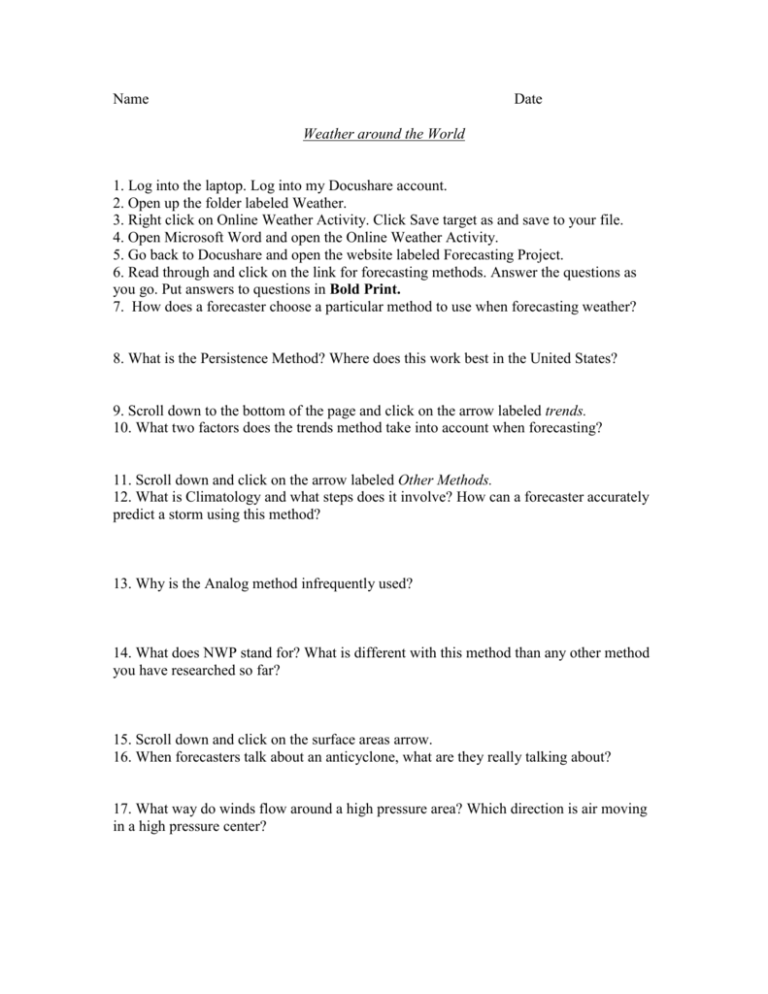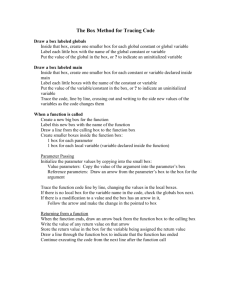Online Forecasting activity
advertisement

Name Date Weather around the World 1. Log into the laptop. Log into my Docushare account. 2. Open up the folder labeled Weather. 3. Right click on Online Weather Activity. Click Save target as and save to your file. 4. Open Microsoft Word and open the Online Weather Activity. 5. Go back to Docushare and open the website labeled Forecasting Project. 6. Read through and click on the link for forecasting methods. Answer the questions as you go. Put answers to questions in Bold Print. 7. How does a forecaster choose a particular method to use when forecasting weather? 8. What is the Persistence Method? Where does this work best in the United States? 9. Scroll down to the bottom of the page and click on the arrow labeled trends. 10. What two factors does the trends method take into account when forecasting? 11. Scroll down and click on the arrow labeled Other Methods. 12. What is Climatology and what steps does it involve? How can a forecaster accurately predict a storm using this method? 13. Why is the Analog method infrequently used? 14. What does NWP stand for? What is different with this method than any other method you have researched so far? 15. Scroll down and click on the surface areas arrow. 16. When forecasters talk about an anticyclone, what are they really talking about? 17. What way do winds flow around a high pressure area? Which direction is air moving in a high pressure center? 18. Scroll down and click on the arrow labeled Cyclones 19. What is a cyclone? 20. Which direction do winds flow around a low pressure system? 21. What kind of weather is associated with a southerly wind? Northerly wind? 22. Scroll down and click on the cold fronts arrow. 23. The air mass behind a cold front is usually ___________ and ____________ than the air before the front. 24. Right click on the diagram for the cold front. Select copy and then paste the picture below. Cold Front 25. What type of weather is associated with cold fronts? 26. Click on the Warm Fronts arrow 27. What can we expect behind a warm front? 28. Right click on the image of a warm front. Select copy and then paste the picture below. Warm Front 29. What type of weather can we expect with a warm front? 30. Click on the arrow labeled Stationary Fronts. 31. What type of weather can we expect with a stationary front? 32. Click on the arrow labeled Occluded Fronts. 33. What happens to for an occluded front? 34. What occurs when the storm intensifies? 35. Click on the arrow labeled Dry Lines. Read through this page and then click on the arrow labeled. Temperatures. 36. What happens if skies are clear? 37. What happens if skies are cloudy? 38. What hint could you use when forecasting on a cloudy day? 39. How is the nighttime situation different than the day time? 40. Click on the High and low arrow. 41. What would you predict the weather to be like when a high pressure center approaches? 42. Right click on the High pressure center image. Select copy and then paste it below High Pressure Center 43. What would you predict the weather to be like when a low pressure center approaches? 44. Right click on the Low pressure center image. Select copy and then paste it below Low Pressure Center 45. Click on the arrow labeled Temp Advection. 46. Define Temperature Advections. How does a temperature advection effect a forecast? 47. Click on the arrow labeled Snow Cover. 48. Right click on the image for No snow cover. Select copy and then paste it below. No Snow Cover 49. Right click on the image for snow cover. Select copy and then paste it below. Snow Cover 50. How does snow cover effect a forecast? 51. Click on the arrow labeled Wind. 52. How does wind effect a forecast? 53. Click on the precipitation arrow. 54. Read through and then click on the arrow labeled moisture. 55. Read through and then click on the arrow labeled Rain or Snow? 56. How does snow become rain? Insert the image below and give a description. 57. How does snow stay snow? Insert the image below and give a description. 58. How does snow stay snow when the surface temperature is warmer than freezing? Insert the image below and give a description. 59. On the left hand side of the screen is a link for Hurricanes under the black heading Meteorology. Click on the hurricane link and explore the life of a hurricane. There are some interesting video clips here as well. Take about 10 minutes and explore in a similar fashion that you explored weather forecasting.






